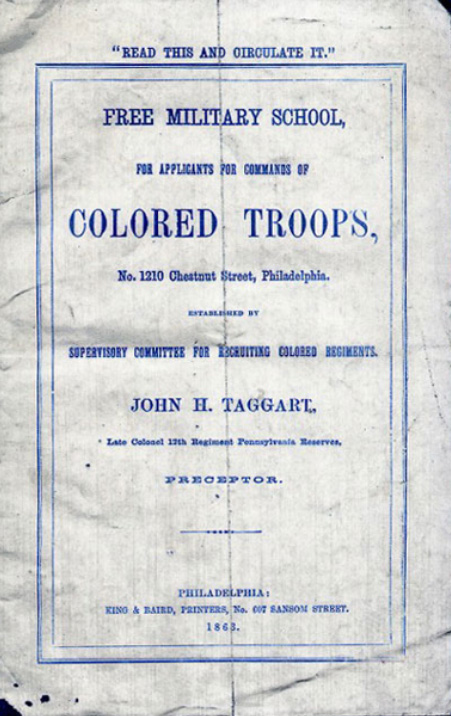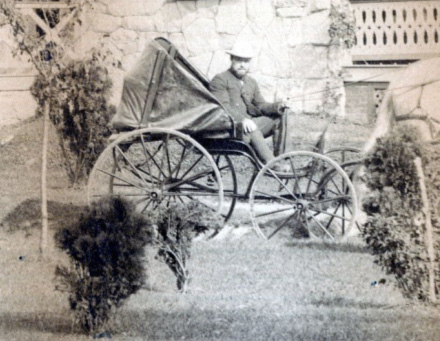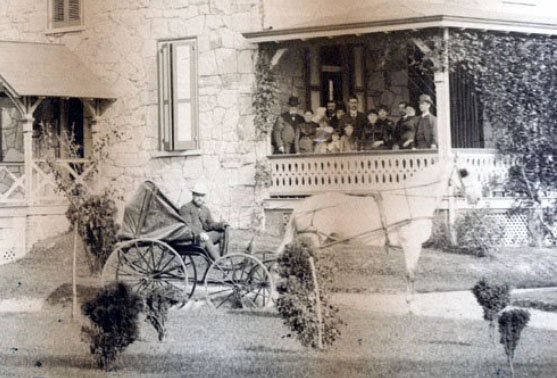Colonel John H. Taggert
Colonel Taggart, (late an officer of the 12th Regiment, Veteran Reserve Corps*), was one of the officers assigned to instruct applicants for commissions as officers for the newly formed United States Colored Troops.
* Report of Col. John H. Taggart, Twelfth Pennsylvania Reserve Infantry
DECEMBER 20, 1861.—Engagement at Dranesville, Va.
O.R.– SERIES I–VOLUME 5 [S# 5]
HEADQUARTERS TWELFTH REGIMENT, THIRD BRIGADE,
MCCALL’S DIVISION, PENNSYLVANIA RESERVE CORPS,
Camp Peirpoint, December 21, 1861.
Brig. Gen. E O. C. ORD,
Commanding Third Brigade, McCall’s Division, P. R. C.
GENERAL: Pursuant to orders from brigade headquarters, the regiment under my command, numbering 575 officers and men, marched out upon the Dranesville pike yesterday morning between 6 and 7 o’clock, took position on the left of the brigade, and advanced towards Dranesville. Nothing of special importance occurred until about 1 mile west of Difficult Creek, when the scouting parties reported that a considerable force of the enemy, numbering about four regiments, were drawn up on a field about 1 mile to the left of our line, apparently Watching our movements. I immediately halted my regiment upon receiving this information and formed line of battle facing the enemy, but as they showed no disposition to engage, after waiting some time the regiment was again put in march towards Dranesville.
On approaching the village our flanking parties were driven in by large force of the enemy who were posted in the woods, a dense thicket of pines, on our left. Our scouts reported that they had been fired on by troops concealed in the woods. The fire was returned, when the enemy in large numbers showed themselves and pursed our scouts for some distance towards the left of my regiment, which was instantly halted and formed into line to receive the attack on the turnpike road. My right rested on the hill leading into Dranesville, and the left opposite a brick house on the left of the pike, and behind which the enemy appeared to be in force.
At this juncture Adjt. S. B. Smith was dispatched to you on the right of the brigade, informing you of the stale of affairs. Your immediate presence at the scene of attack, and the timely support of the other regiments of the brigade, the Kane Rifle Regiment, the cavalry force, and Easton’s battery, are facts which came under your own notice, and therefore need no further mention from me.
Before the regiments had got fairly into position the enemy opened with a heavy fire of shot and shell, which tell thick and fast in the vicinity of the left of my regiment. The shells at first exploded in our rear, tearing up the ground and splintering the fences in every direction, but fortunately did no damage to the men under my command. After firing about fifteen minutes the enemy succeeded in getting a better range, and the shells burst over our heads, but without injury, the men on the left, the most exposed portion of the regiment, being ordered to lie flat on the ground.
Easton’s battery now opened upon the enemy from our left with such effect that the firing from the enemy ceased for a time, and we were relieved from the most annoying situation in which a soldier can be placed, that of receiving a fire from the enemy without returning it, which we could not do, as the enemy were entirely hidden from view. The conduct of the men during the time they were under fire, nearly all of them for the first time, was most commendable. There was no flinching, and the line was preserved unbroken.
At this time, by your orders, I dismounted, leaving my horse in the road, and on foot conducted the charge of my regiment into a dense woods opposite the right wing for the purpose of capturing the enemy’s battery. We advanced into the woods as rapidly as the nature of the ground and the dense growth of timber would permit, without finding the enemy. We then advanced with a full battalion front to the left, where a heavy firing of musketry was going on. Before we emerged from the woods the firing ceased. We soon gained an open field, in the direction of the enemy, where we halted and awaited orders, which were received from you, to charge into a wood in our front and take the enemy’s battery, which was believed to be only a short distance item us. This order was instantly obeyed, and the Twelfth Regiment dashed into the woods. We scoured the thickets in every direction without finding the battery, but discovered dead bodies of the rebel troops lying in every direction, besides a number of wounded, who were properly taken care of and sent to the rear. We continued the pursuit for a considerable distance without meeting the enemy, but on every side there were evidences of a precipitate flight– arms, ammunition, clothing, and provisions being strewed around in every direction.
By your orders we were recalled, and returned by way of a road we had crossed before charging into the woods. Here we discovered the location of the enemy’s battery by the piles of cannon balls, shells, and munitions of war. There was one gun-carriage destroyed by the pioneers of my regiment, which was found damaged from the effects of our shot and shell.
The conduct of the officers and men, under the difficult circumstances in which they were placed, in searching a dense forest for a hidden foe, was eminently satisfactory. I desire to mention particularly the services rendered by Quartermaster E. D. Reid, who acted as my adjutant on the occasion. None of the field officers were on duty except myself, and but three captains out of nine. Notwithstanding these disadvantages, the subaltern officers and the men conducted themselves with spirit and bravery, and obeyed with alacrity the orders given them.
I am gratified to have only one casualty to report. Private William R. Fox, of Company K, was shot in the right thigh during the first part of our advance into the woods. The wound is not serious. He made a narrow escape. A porte-monnaie in his pocket was bored through, and a $2.50 gold piece in it was bent nearly double.
I have the honor to be, general, your obedient servant,
JOHN H. TAGGART,
Colonel, Commanding Twelfth Regiment P. R. C.
Source: “Official Records of the War of the Rebellion
Recruiting of Colored Regiments: Written by Colonel John H. Taggart
http://www.millikensbend.org/articles-docs/taggart/taggart.html
Recruiting Poster

Editors Note: The following pictures of Colonel Taggart are a result of a. generous gift from Mr. Clifford K. Baylis of Thomasville, NC. The photographs were made on September 27, 1885 by Gilbert and Bacon, 820 Arch Street and 40 No. 8th Street in Philadelphia, Pennsylvania.

